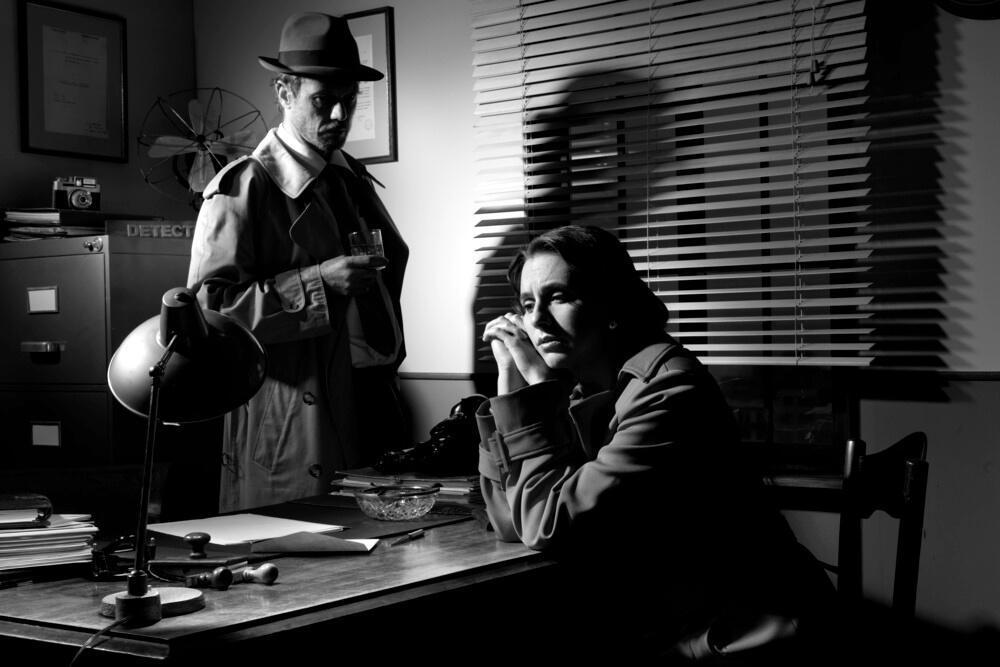The term “film noir” literally translates in “dark film.” The term was coined by French critics to describe the downward trend they were seeing in newly released Hollywood films. In these films, the hero was the antihero, the ingenue was the femme fatale, the endings were anything but optimistic, and people smoked like cigarettes were going out of fashion.
Some loved them for their stark cynicism, others criticized them for their lack of morality, but there was anything both sides to agree on, it was that film noir had style. Here are a few of the most stylish film noir productions that you may want to “cop” some style from.
They Live by Night (1948)
The lights dim, the film begins, a shot of a boy and girl enwrapped in one another’s arms voiceover: “This boy and this girl were never properly introduced to the world we live in…..” A car horn, the two turn toward the camera in alarm and the title appears; “They Live by Night.”
“They Live By Night” is the story of Bowie Bowers and his girlfriend, Keechie Mobley. Bowie is a 23-year-old ex con, jailed at 16 for killing the man who murdered his father. Bowie along with fellow prison escapees, T-Dub and Chicamaw “One-Eye” Mobley are on a crime spree. Keechie, Chicamaw’s niece is along for the ride. Sparks fly and Bowie and Keechie lam it cross-country.
The end is a little more gris than noir, the sympathy is with the young crook, but it tends to focus on sentimentality over crime. The perfect tooth cutter for film noir newcomers.
The Big Sleep (1946)
The year is 1946. Private detective Philip Marlowe, played by Humphrey Bogart, is summoned to the mansion of General Sternwood. It seems the general wants to resolve some gambling debts his daughter Carmen owes. As Marlowe is leaving, he is approached by the older Sternwood sister, Vivian, played by Lauren Bacall. She thinks her dad’s got an ulterior motive.
What goes on from there is a wickedly shrewd plot, a nightmare blur of wrongdoings and double crossings, with little to clear it at the end. Is it wickedly clever or just wicked? You be the judge.
Sunset Boulevard (1950)
It all begins when Joe Gillis (William Holden), failed Hollywood writer, is lured into the surreal world of Norma Desmond (Gloria Swanson). Norma is a faded silent film star who dreams of her triumphant return to the silver screen, casting everyone around her to play a role in her delusional fantasy. Joe is next.
As Joe’s relationship with Norma develops, he begins to realize that Norma is anything but normal. She starts to lavish attention on Joe and buys him frivolously luxurious gifts. It comes to a head at Norma’s New Year’s Eve party, when Joe finds himself the only on the list, and realizes he is the object of not only Norma’s attention, but her affection as well.. FYI: Norma is also suicidal.
The ending is typical film noir. Joe tells Norma she’s never going to make a comeback, she takes out a gun and threatens to shoot herself but ends up shooting Joe instead. Joe ends up in the pool. Norma makes an impromptu speech about how thrilled she is to be back in the public eye again, and ends with the immortal words, “All right, Mr. DeMille, I’m ready for my close up.”
Kiss Me Deadly (1955)
Meet Mike Hammer, Private Investigator, played by Ralph Meeker. Mike is a hard boiled- dyed in the wool detective. His assistant/ lover, Velda, played by Maxine Cooper works on “penny-ante divorce cases.”
The plot begins to twist when one evening, on a deserted road, Mike gives a ride to a hitchhiker, Christina (Choris Leachman) wearing nothing but a trench coat. She’s also freshly escaped from a mental institution. Thugs waylay them and torture Christina to death. They end up pushing Mike’s car off the cliff with an unconscious Mike and dead Christina inside. Mike wakes up in a hospital next to Velda and tells her he is going to pursue the case.
The plot unfurls to reveal sexy waif like women, mysterious boxes that contain treasure, hostages, gunshots, and rooms bursting into flames. Hammer and Velda emerge, just barely, to fight another day. See “My Gun is Quick” for the sequel.
The Asphalt Jungle (1950)
It all begins when criminal mastermind Erwin “Doc” Riedenschneider, played by Sam Jaffe is released from prison, only to revisit his past. Doc goes to see a bookie named Cobby, (Mark Lawrence) who arranges a meeting with a lawyer. Turns out, Doc’s got a plan to rip off some jewelry worth a half a million or more. He needs $50,000 to hire three good men; the box man
(safe cracker,) a “hooligan” to help pull off the caper and a driver. The lawyer agrees to put up and shut up.
The heist goes off, but not without a hitch. The men get away but it’s too late, the police manhunt has begun.
Enter double crosses, blood transfusions, and beatings, but most importantly, enter Marilyn Monroe in her first important role. Even with a supporting role, she managed to make the box cover for the video.
Chinatown (1974)
A woman identifying herself as Evelyn Mulwray (Faye Dunaway) hires private investigator J.J. Jake Gittes (Jack Nicholson) to follow her husband, Hollis Mulwray, chief engineer for the Department of Water and Power. It seems Mulwray’s got a mistress on the side and Evelyn wants some damning evidence (no pun intended).
Gittes gets the pix but finds out he was set up. Mulwray is the real target here. Turns out the water company is drying up the land, so it could be bought at a cheaper price, and Mulwray found out. Now he’s swimming with the fishes.
Confrontations take place, and it’s a bad scene allover. “Forget it Jake, its Chinatown,” and the movie ends.
The Third Man (1949)
The setting: allied occupied Vienna, post WWII. Opportunistic racketeering thrives. American pulp western writer Holly Martens (Joseph Cotton) comes to the impoverished city seeking his child hood friend, Harry Lime. It seems Lime has a job for Martens and Martens is interested.
Martens arrives, only to find Lime has just been killed hours earlier by a speeding truck while crossing the street. Martens attends Lime’s funeral, where he meets two British army police who happen to be fans of Martens’ writing. Turns out, Lime was a criminal; the blues advise Martens to leave town toot sweet.
Martens doesn’t leave, seems he has some unfinished business to attend to. While he is there, Lime (Orson Wells) turns up alive. The fix is in. A rendezvous is arranged between the two men, but the girl interferes. Lime tries to escape through the sewers, but the police are out in force. Guns go off, a shot is heard, Martins ends up attending Lime’s funeral for the second time. Nobody gets the girl.
Laura (1944)
NYPD detective Mark McPherson (Dana Andrews) is investigating the murder of Laura Hunt (Gene Tierney), beautiful, successful advertising exec. Apparently, Laura ended up at the wrong end of a shotgun blast to the face, just inside the doorway to her apartment.
McPherson interviews the suspects; the mentor, the playboy finance, the socialite aunt. A picture of Laura begins to form. McPherson becomes obsessed.
The plot twists when Laura turns up alive. She is a tribute to classic film noir style over sanity. The absurdities and impossibilities contribute to the film’s appeal. While artificial and contrived, in the end, the film is a well-crafted murder that balances low morals with high style.
The Woman in the Window (1944)
When we first meet psychology professor Richard Wandley, he has just sent his wife and children off on vacation and goes to meet his friends at the club. There, he becomes fixated on an oil painting of Alice Reed (Joan Bennett) in storefront window. When he leaves the club, he finds Reed standing there; she convinces Wandley to join her for a drink.
The plot thickens when the two go back to Reed’s home and find her rich lover, Claude Mazard, (Arthur Loft) has just popped in for a surprise visit. Wandley kills Mazard, but his work is sloppy. There are too many clues, too many witnesses, too many loose ends that need tying up. The suspense is palpable, the timing is perfect, the ending, one you’ll never see coming.
The Big Heat (1953)
Officer Tom Duncan of the Kenport Police Department has just committed suicide. Homicide detective Sergeant Dave Bannion, played by Glenn Ford, is on the case. Duncan’s wife, Bertha claims her husband had been in ill health before his death.
Bannon is contacted by Officer Duncan’s mistress, Lucy Chapman (Dorothy Green) who says Tom had not been in health. Bannon goes back to the widow, but she’s not so friendly this time.
The next day, Bannon is warned to close the case. Bannon smells a rat.
Unlike most film noir, it this movie, there is no femme fatale. Rather there are a lot of females who suffer near fatalities.
Lucy Chapman ends up dead, tortured, strangled and covered in cigarette burns. A crime syndicate blows up Bannon’s car with Bannon’s wife, Katie, inside. A mafia princess gets a pot of boiling water thrown in her face, leaving her permanently disfigured.
Misogynistic? No doubt. Film noir? Absolutely. Add this one to your list just for the imagery alone.
Double Indemnity (1944)
The movie starts in the present day. Insurance salesman Walter Neff (Fred MacMurray) staggers into his office, a gunshot wound on his shoulder. He begins to record a confession on his Dictaphone. The story ensues in flashback…..
On a routine insurance sales visit, Ness finds himself in the house of the alluring Phyllis Dietrichson (Barbara Stanwick). Stanwick begins questioning Ness about how she can take out an insurance policy on her husband. Ness suspects foul play and wants no part of it, but he just can’t keep the girl off his mind and when Phyllis shows up at his apartment, it seems he can’t keep her off his body either.
Post congress, the two cook up a plan to make it look as if the husband has fallen off a train. This will trigger what is known in insurance talk as “the double indemnity” clause. If all goes as planned, the policy will pay out twice its value. Then again, in film noir almost nothing goes as planned.
Barbara Stanwick in the role of Phyllis Dietrichson has come to define the standard for the femme fatale in film noir. She proves to be cold hearted through and through. However, the biggest shock at the end of this film is not so much the fact that she manages to blindside Neff, but that she manages to blindside the audience.
Scarlet Street (1945)
Scarlet Street begins with Chris Cross (Edward G. Robinson), amateur painter and clothing store cashier leaving a company party in his honor. Chris is in a loveless marriage with his wife Adele who is still obsessed with the memory of her husband. As Chris leaves the fete, he remarks to his associate about “what it would be like to love a young girl. Be careful of what you wish for, Chris, you just might get it.
Walking home, Chris comes to the aid of Kitty (Joan Bennett) who is being attacked. by stunning her assailant with his umbrella. Gullible Chris is unaware that this man is really Kitty’s boyfriend and he has just become the pawn in a ruthless con game that wouldn’t end until Chris’ pockets are empty and his life is ruined.
When Scarlet Street came out, it was called “obscene, indecent, immoral, inhuman, sacreligeous, and was noted for its likelihood to “corrupt morals and incite crime.” Universal was discouraged from challenging the censors.
Today, film noir is accepted as an art form and still remains a valid and renowned artistic form of cinematic expression.
What’s your verdict?






Leave A Comment